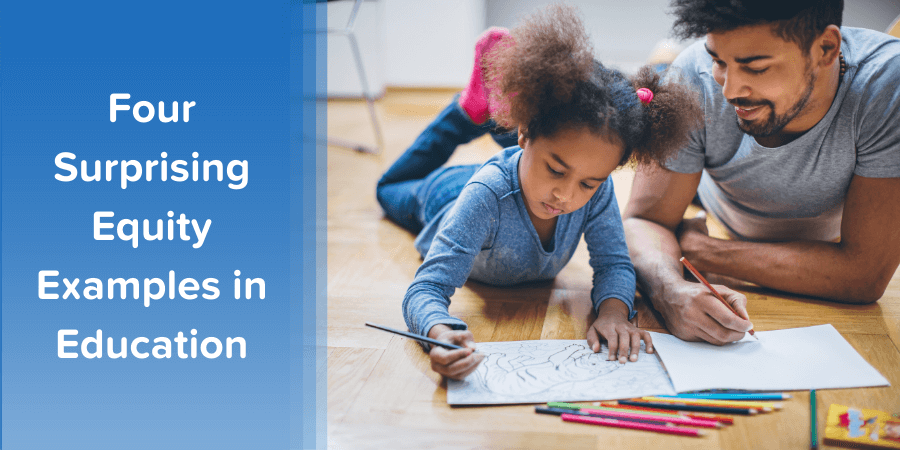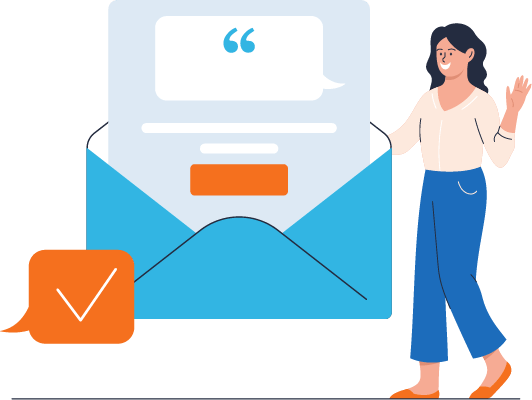by ParentPowered contributing author Curran Mahowald, M.A. Cognitive Science in Education
Equity in schools is about understanding and meeting the needs of all learners. Sometimes, this means designing custom solutions for specific students based on their unique strengths and needs. For example, a preschool teacher with multilingual learners who aren’t yet comfortable communicating in English might create visual cue cards that the children can point to when they need to use the restroom or get a drink of water.
But often, these strategies come in handy for more students than expected. Those visual cue cards originally meant for multilingual learners? They enable all students to communicate with the teacher silently during nap time.
This example illustrates an overarching principle that holds true in educational settings and beyond: Accessible design is simply good design.
To see how this is true, think about how sidewalks are designed with sloping parts of the concrete. This feature was originally put in place to help veterans who returned home from World War II with disabilities. However, this accommodation also helps many other people, from caregivers with strollers to delivery workers pushing carts.

In the first part of this series, we covered 5 real-life ways educators promote equity, from whole-child early education to family engagement for linguistically diverse families.
In this article, you’ll meet four educators using solutions that may seem specific to individual needs but actually set all students up for success. We hope these equity examples in education inspire you to design effective learning strategies for all students!

1. Learner-centered design for all learners
Kyle Redford, 5th grade teacher in Marin County, CA (Opinion Piece for EducationWeek)
Removing barriers and providing support for all learners is always a good idea. So good, in fact, that this principle has a name: universal design for learning (UDL). UDL is an approach to make instructional materials accessible to all learners. Fifth grade teacher Kyle Redford is a champion for UDL in her classroom and beyond.
Accessible design is good design
She can personally attest to the idea that the benefit of creating options for learning goes beyond students with disabilities or different learning styles: “[W]hen I adapted the delivery of my content, introduced assistive technology for school work, or granted an assessment accommodation for one student, it usually became a helpful practice for many.” One example of this was the installation of an amplification system meant to help a student who was hard of hearing. Students without the disability also had an easier time following along with class directions and explanations. Planning for educational equity helps the whole classroom.
Multiple modes
Although the idea of “learning styles” in its traditional sense has been debunked, research does show that all students benefit from multimodal presentation of information.
For example, texts that are above students’ reading ability can be read aloud to them, making audio a useful scaffold for the visual consumption of text. Redford makes use of audiobooks, podcasts, videos, and text-to-speech apps to help students access the subject content even if they struggle with reading.

Using these technologies can strengthen students’ decoding abilities while allowing them to consume information.
Redford also makes written text in the classroom available digitally, which can help less-organized students and those who need text-to-speech. Dictation apps and software can also help students who struggle with writing mechanics.
Know your students
One reason Redford is so successful in providing equitable education is that she really knows her students. Every student comes from a unique background and possesses a distinct set of skills, knowledge, and experiences. When designing instruction, Redford takes into consideration the diverse interests, needs, and abilities of students.
This not only leads to a more engaging and effective learning experience for students but also helps to create an inclusive classroom environment where every student feels valued and supported. By leveraging input from students, teachers can help students to develop a love of learning and achieve academic success.
Mindset shift
Redford’s work in UDL started with making changes designed to help individual students. But soon she found herself thinking about education systems at the classroom level. Although professional development can certainly help educators foster inclusion in education, a mindset shift toward creating equitable opportunity for students to learn may be all it takes to begin.
Creating a more inclusive learning environment has involved no unique expertise, just a shift in
Kyle Redford, CA
instructional thinking and practice.
Explore these resources to learn more about universal design for learning:
- Q&A with experts from the University of Nevada, Reno’s Office of Digital Learning
- A teacher’s guide to Universal Design for Learning from Understood.org
- Cast.org website

2. Alternative grading for equity
Robert Talbert, math professor in Allendale, MI (Interview for EdSurge Podcast)
When you think of grading, you probably envision a tally of points, a letter grade, and lots of red ink. The traditional score-based method of grading has been the norm in the U.S. for a couple of centuries. It provides a convenient way to compare students across public schools or know where to place a child who changes schools.
However, there is a growing realization among educators that this system might not be the best way to promote positive outcomes for student learning.
Robert Talbert was one of those educators who used traditional grading methods. He had been assigning points and scores and letters, even using a red Sharpie, for decades before he noticed any negative impact.
The trajectory of one student in his calculus class opened his eyes. At the beginning of the semester, Robert Talbert says, this student was excited to learn and was clearly mastering skills and grasping concepts during class time. She was even emerging as a leader as she explained problems to other students.

She also happened to be a student who struggled with taking tests, and she received a poor score on the first exam of the semester. Because of the course assessment structure, this score precluded her from earning an A in the course overall.
According to Robert Talbert, her motivation and engagement changed completely after that first test. She went from being positively engaged to acting out and even discouraging other students. Talbert’s takeaway? Bad grading systems can wear down promising students. And he was concerned that the students most likely to be hindered by traditional tests are students who face other barriers as well, such as mental illness, disability, or limited English language proficiency.
He felt that traditional grades are a measure of students’ ability to take a test, not their mastery of concepts. It’s a snapshot of performance at a single point in time, and not all students are equally good at performing under pressure.

In pursuit of equitable outcomes, he developed alternative grading methods to create a level playing field.
Equitable grading for all students
There are four main components that Robert Talbert includes when designing a grading system that sets all learners up for success.
- Clearly defined standards. Teachers should explain the standards students need to meet in order to demonstrate mastery, ideally based on state standards. Explicit classroom expectations give students equitable access to the knowledge needed for success.
- Helpful feedback. Teachers should give meaningful, actionable feedback on student work. A number or a letter gives little information about what students did well or how they can improve. A short comment explaining how their work differs from the expectation can go a long way.
- Progress-focused marks. Marks should indicate progress instead of treating one test as the ultimate indicator of capabilities. What ability is the student demonstrating now that they didn’t have before?
- Try, try, and try again! Finally, in an equitable classroom, all students should be permitted to reattempt their work without penalty. This completes the feedback loops that began with the actionable feedback they received on their work.
Explore these resources learn more and explore grading equity examples in education:

3. Radical Representation
Joshua Brown, former SPED student and current school board member in Shasta, CA (Report by EdSource)
Policy decisions in public education have a profound impact on the lives of students, teachers, and communities. Having students, families, and educators involved in the policy-making process can result in policies that are more effective, equitable, and responsive to the needs of all learners.

We often talk about how leaders should think about the needs of traditionally underserved groups when making decisions. But ideally, the people from the traditionally underserved groups are the ones making the decisions.
Advocacy from the inside
That is the case in Shasta, California where the newest school board member has direct experience with the district’s special education program. Joshua Brown has autism and was a student in the district not too long ago. He faced both academic and social challenges in his school community. But now he’s in a position to make a difference and promote inclusion in education. He is well-read on educational policy and talks about it with his father, also a school board member.
As a school board member, he plans to advocate not just for students with disabilities but also those students facing income inequality, dealing with mental health concerns, and struggling with academic achievement. He believes educational systems can do more to ensure all students are set up to benefit from high-quality education. For example, smaller class sizes and community partnerships to help families find housing and jobs are also on his agenda.
As a natural leader, Joshua Brown has aspirations of holding higher public office. But for now, he is intent on removing barriers to equity in his own school community.
Explore these resources to learn more about diversity and representation in leadership:
4. Strengthen the Home-School Connection with All Families
Lanre Ajayi, Early Learning Program Coordinator in west Contra Costa County, CA (ParentPowered Case Study)
Building connections between parents, caregivers, and schools is undoubtedly important for a child’s education. The steps needed to build these connections can vary depending on the culture and circumstances of the students’ parents and caregivers. Some families may feel valued through volunteering or participating in school decision-making, while others prefer asynchronous communication. Providing basic information about the school system can help those who are new to it feel set up for success. Communication should also be tailored to individuals’ preferences, taking into account factors such as reliable internet access and language barriers.
Education leaders in diverse districts know that equity in education means building meaningful partnerships with a wide variety of families. That’s why Lanre Ajayi explored a text-message-based parenting curriculum as a part of her district’s family engagement strategy. As a low-tech, high-impact curriculum, ParentPowered helps meet diverse needs in several ways.
First, by breaking the complexity of responsive parenting and child development into bit-sized pieces, it works for parents who are busy working. It empowers them to use the simple moments they already spend with their child, such as bringing them to school or running errands, as learning opportunities.
Second, it also tips the balance of school-home communications toward the positive, which helps build productive relationships. Parents and caregivers receive weekly text messages that play to their strengths and encourage them as their child’s first teachers.
It may seem unconventional to look to text messages for guidance to handle intense emotions, but that’s exactly what families in Lanre Ajayi’s district do with ParentPowered. Messages are designed to help families build resilience and children build social-emotional skills in fun and easy ways.

Explore these resources to learn more about family engagement to close the equity gap:
- The Dual Capacity-Building Framework for Family-School Partnerships
- Research Digest on Benefits of Family Engagement for Students
- Video interview with Dr. Karen Mapp on parent and family engagement

Building a world where demography doesn’t predict destiny
These are just a few of the many equity examples in education. These educators are using accessible design to create an environment that facilitates learning for all students. Their stories show that there is no tradeoff between equity and effectiveness — equitable educational practices are effective educational practices. Although we often imagine personalized solutions when we think of equity, making these solutions universally available can have a powerful impact on all students.
Equitable solutions can be simple and elegant, but they don’t get implemented without intention. It is important to take an equity lens from the very beginning of any instructional design or policy-making process. This is because the foundational aspects of the solution often depend on the learners’ needs.
For example, the ParentPowered ParentPowered program is a parenting curriculum delivered by text message. When they developed this idea, the program’s creators were specifically looking for ways to close the achievement gap in early childhood education by reaching low-income families. This led to the design choice to use texting, which avoids the need for internet access and reaches 97% of adults in the U.S. Although this solution was conceived with children and families from one particular socioeconomic status in mind, the end result is convenient for nearly all families! The texting format had implications for the structure of the content—it had to be written clearly and simply in bite-sized pieces that could be delivered one at a time.
Equity in education means that demography should not predict destiny. Creating educational solutions with universal accessibility is one important way to give students the power to design their own destinies.
Missed the first part of our series? Click here to discover more uplifting equity examples in education.

About the author
Curran Mahowald is a former high school language teacher turned education research advocate. In addition to having worked at ParentPowered, she has also designed parent-facing informational materials at Oakland Unified School District and currently works on improving national research-to-practice infrastructure at the Annenberg Institute for School Reform at Brown University. Curran holds an M.A. in Cognitive Science in Education from Teachers College, Columbia University and B.A.s in Linguistics and French from the University of Southern California.





